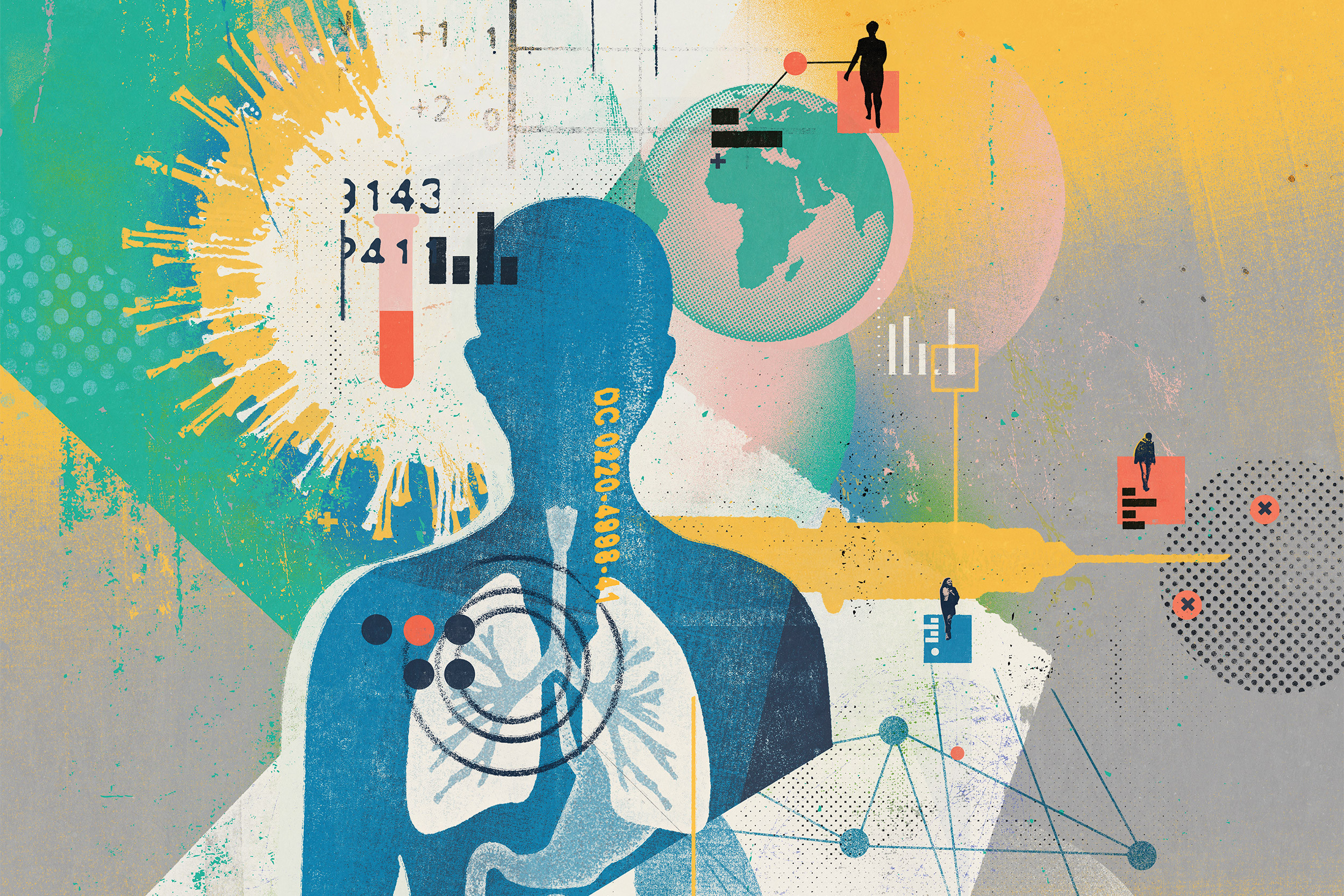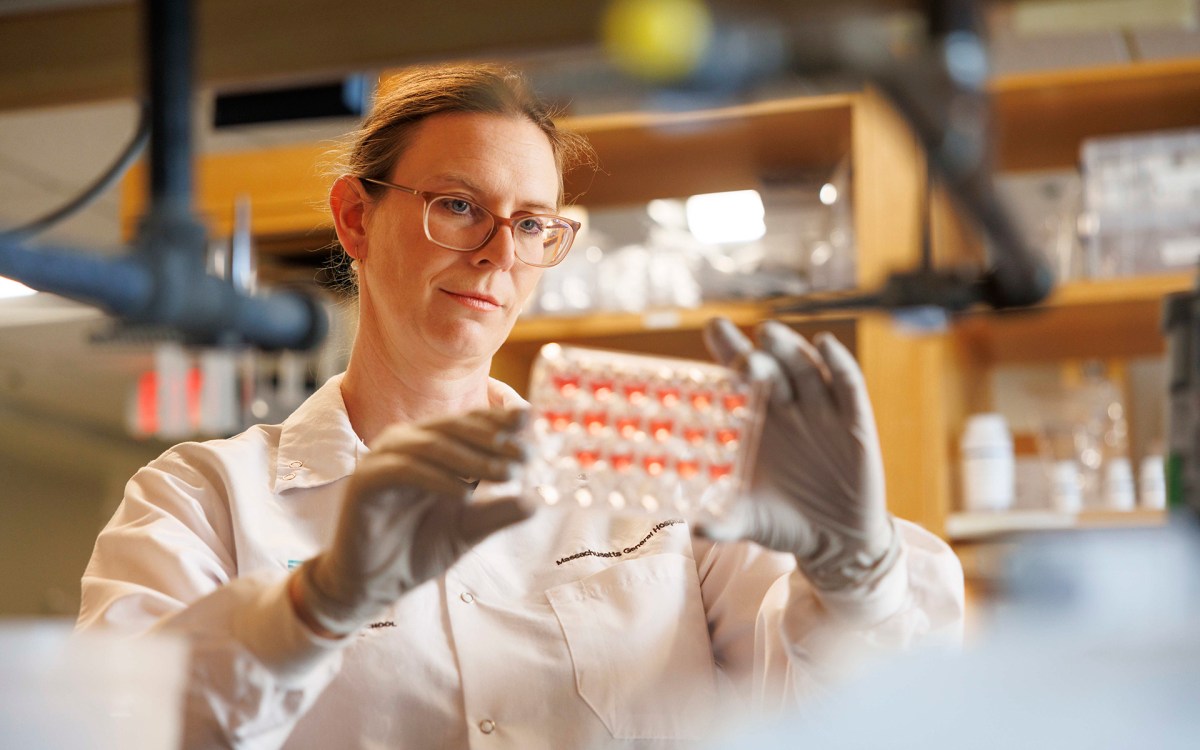
Illustration by Stuart Kinlough
Is pandemic finally over? We asked the experts.
Harvard faculty on changes to views on school, work, winter’s likely surge, danger of ‘lethal inflexibility’
Public health officials agree that the end of the pandemic is in sight but not here yet. So where does it leave educators, top business executives, and public health experts? Adjusting to a world of constant vigilance for COVID flare-ups, accepting hybrid workplaces, hustling to make up for lost school time — and avoiding “lethal inflexibility” if the virus mutates into a more deadly threat.
Officials at the World Health Organization say that many nations have a pretty good handle on what’s going on given the spread of vaccines, rise of effective treatments, and immunity conferred by the large number who have had the disease. However, they said in late September that both the ongoing global death toll — 10,000 a week — and the prospect that the continuing, widespread transmission around the world will spawn a dangerous new variant prevents them from declaring an end to the COVID-19 emergency.
WHO director general Tedros Ghebreyesus and Maria Van Kerkhove, technical lead of WHO’s pandemic response, said that though the advent of vaccines and effective treatments have transformed the fight against the ailment, doses remain scarce in some low- and middle-income nations. And the more the virus circulates, they said, the more chances it has to mutate into something worrisome.
“The refrain of the pandemic has been that no one is safe until everyone is safe,” Ghebreyesus said during a media briefing. “The pandemic is not over, but the end is in sight.”
William Hanage, associate professor of epidemiology and co-director of the Harvard T.H. Chan School of Public Health’s Center for Communicable Disease Dynamics, said despite the temptation to consider the pandemic over, past lessons caution us to wait and see. Last winter’s Omicron variant provided an unforgettable example of the need to not let our attention wander. Though not as virulent as other variants, Omicron’s constellation of mutations stunned scientists when it appeared last fall and fueled its breathtaking spread around the world in the weeks that followed. It rapidly displaced earlier variants and, though not as dangerous on a case-by-case basis, the sheer number of infections it caused have made Omicron much more deadly.
“The thing which most people would be nervously looking for is the possibility of a variant that has properties like Omicron, in terms of being able to infect lots of people but which also is more dangerous in the way that Delta was,” Hanage said. “If Omicron had been as virulent as Delta, things would have been much worse.”
Omicron has also proven disturbingly prolific, and subvariants continue to emerge. WHO officials said that though Omicron represents 99 percent of all SARS-CoV-2 out there today, there are some 300 Omicron subvariants that are being monitored, including BA.5 — widespread in the U.S. — BA.2.75 and its subvariants, BA.4.6 and its subvariants, and BF.7, itself a subvariant of BA.5.
With much of the world either infected or vaccinated — the WHO tallies some 12.7 billion doses given — the pandemic’s ebb and flow is determined by a complex relationship among variants, by rising and falling immunity among humans, and by apparent seasonal effects, Hanage said.
“If Omicron had been as virulent as Delta, things would have been much worse.”
William Hanage, associate professor of epidemiology, co-director of the Center for Communicable Disease Dynamics
Variants that spread rapidly gain the upper hand by efficiently infecting those still uninfected and those vaccinated or recovered whose immunity has waned over time. As people gain immunity to the new strain, the rate of infection slows, eventually favoring other variants that may not spread as rapidly, but that better escape the body’s immune response.
In the U.S., that complex dance appears to be playing out now, Hanage said, with the fast-spreading BA.5 subvariant appearing to have run its course, while BA.4.6, which has greater ability to evade immune defenses, is beginning to spread more widely.
With each of the past two winters seeing large surges in cases whose peak case counts came within days of each other, Hanage said it’s reasonable to expect something similar this fall and winter, even though widespread immunity and availability of a new variant-updated vaccine makes it unclear what that will look like in terms of cases, hospitalizations, and deaths. Given recent trends, it’s likely that illness will be less severe than earlier in the pandemic, though Hanage cautioned that even mild illness, spread widely enough, can be disruptive.
“If everybody in the world got the common cold at the same time, it would be a big deal,” Hanage said. “That’s the thing about a pandemic of this nature. It’s not so much the individual fatality rate; it’s the fact that a respiratory virus is capable of infecting lots of people very quickly. And that means — as with Omicron — flight crews all go down at the same time because they tend to hang out with each other. Same thing with health care workers on a particular ward. Same thing with teachers.”
It is that backdrop of global uncertainty that has Hanage warning against “lethal inflexibility.” While hoping the current lull turns out to be more than that, Americans should get on with their lives, but with an eye on the global and national pandemic situation. In fact, Hanage said, it is only the pandemic’s already staggering toll that makes today’s fatality rates appear “good” by comparison. The virus has already killed more than 200,000 Americans this year, Hanage said, a rate more than four times that of a “bad” flu season.
“The overriding goal for this year is that school should look and feel a lot like it did prior to the pandemic.”
Joseph Allen, associate professor of exposure assessment science
Even should a surge emerge, Hanage and Joseph Allen, associate professor of exposure assessment science at the Harvard Chan School and a healthy-buildings expert, said clear damage already done to children’s education, coupled with the low risk of serious illness for such a young population, means there should be a high bar set for steps that cause further disruption.
“The cost of school closures has been devastating to kids — talk to any parent,” Allen said. “And, whether it’s a second-grader who has never had normal school, or high schoolers who have missed sports or special events like a prom or just social gatherings with friends, this has had major impacts. The overriding goal for this year is that school should look and feel a lot like it did prior to the pandemic.”
Martin West, Henry Lee Shattuck Professor of Education, academic dean at the Harvard Graduate School of Education, and member of the National Assessment Governing Board, which oversees the National Assessment of Educational Progress, said August’s dismal test results from the nation’s 9-year-olds was expected given the widespread pandemic disruptions to schooling, but nonetheless disturbing.
“They show substantial declines in math and reading achievement for the average student. In the case of math, that’s the first time that student scores have declined in the 50-year history of the long-term trends assessment,” West said. “Not only were the average declines substantial, there were big differences in the amount of ground lost by higher- and lower-achieving students.”
Though the tests were only for 9-year-olds, other tests indicate such declines were pervasive in elementary and middle school. In high schools, there are other indicators of lost progress, such as increasing numbers of dropouts and lower numbers enrolling in college.
Since in-person schooling restarted last year, children appear to have resumed their prior progress, but that bit of good news doesn’t address the deficit they had coming back to their classrooms, he said. That can only be made up through additional instructional hours.
West said he would never rule out masking, school closures, or other steps should the need arise, but he thought risk might be balanced differently today than earlier in the pandemic, with effective tools to fight pandemic illness and a better understanding of the risk of staying out of school.
“In retrospect, over the course of the pandemic, we seem to have underestimated the costs of school closures, and perhaps also overestimated the value of school closures in preventing the worst consequences of the pandemic,” West said.
“Should people have to quarantine and they’re not very sick, they’ll keep at it. We’ve already seen a reduction in absenteeism with the presence of remote work.”
Tsedal Neeley, professor of business administration, senior associate dean for faculty development and research
Tsedal Neeley, Harvard Business School’s Naylor Fitzhugh Professor of Business Administration and senior associate dean for faculty development and research, said that though another surge remains possible, businesses and workers are looking ahead not to more potential temporary measures, but to what the permanent, post-pandemic workplace will look like.
While Labor Day’s unofficial end of summer marked a time when many businesses required previously remote workers to return to the office, what that “return” looks like varies from place to place. What’s become apparent, said Neeley, who wrote a 2021 book on remote work, is that the hybrid model — where professionals, particularly so-called knowledge workers, spend a couple of days in the office each week and the rest working remotely — has won.
Many bosses, she said, would prefer workers return full-time — or at least most of the time — citing the need for in-person collaboration, to oversee and motivate staffs, and to foster corporate culture. But one indelible pandemic lesson is that employees can be effective working remotely, and, despite some wobbles, the economy continues to favor workers over employers.
“Many companies thought that they would have an upper hand because of the economic uncertainties, but employees continue to have power because the right people are still hard to hire and retain,” Neeley said. “Because of those dynamics, employers don’t have the number of people that they need in order to meet their objectives. It’s kind of a tricky place.”
A plus of the emerging hybrid workplace, Neeley said, is that it bakes flexibility into knowledge workers’ practices. And keeping remote work part of the picture keeps that workforce resilient against a pandemic resurgence.
“Should people have to quarantine and they’re not very sick, they’ll keep at it. We’ve already seen a reduction in absenteeism with the presence of remote work,” Neeley said. “The norms around digital tools have been so well established that it’ll be quite seamless.”








